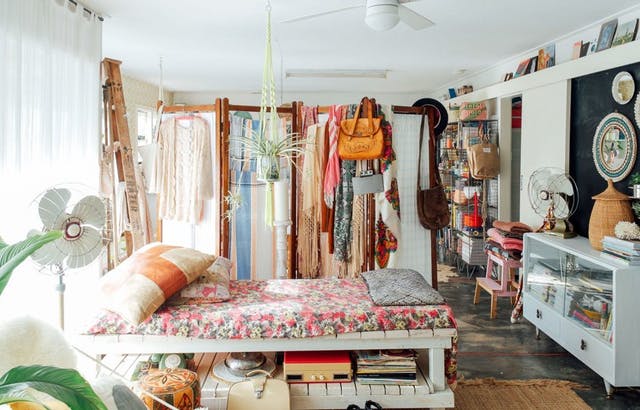
Stuff. We all have it, some more than others. Stuff is the things that we have bought, found, inherited, collected and happened upon. Some of the stuff might be valuable, some might just be worthless but we liked it at the time and we still have it. To me, stuff is like stuffing; it fills up the space but doesn’t always have a real significance, to my life, to my needs and to my existence. So why do we have all of this stuff?
It makes us feel full, warm, safe. But it also causes us to be sluggish, and worn down because we are always worrying about the stuff and where it belongs, and how to take care of it, until we stop and it consumes us, and takes up too much space and way too much effort. We spend lots of money on storage units to keep the stuff that has no room in our homes, and we forget about it anyway.
I wouldn’t say I am a minimalist. Far from it. But I think collecting and keeping things has to have significance. There is the saying “One man’s trash is another man’s treasure,” and that is true, but things that have an expiration date, such as newspapers, magazines, old bills, and even clothing that hasn’t been worn in a very long time, take up space, create dirt and dust, and really clutter the environment. And old expired food, cosmetics, medicines and prescriptions, go one step further; they can become a health hazard.
We need to really think about what we save, and why we save it. Does this stuff really give us joy? Wouldn’t the freedom from stuff give us clearer direction and an opportunity to explore and pursue a more fulfilling life? If everything you keep has an active purpose, I say keep it. If you are keeping things because you think you might use them someday, do a real assessment of those things.
So, how can you do a real assessment? Actually, it’s relatively simple.
1. Tackle one space at a time
When you look at everything all at once it can be overwhelming (and you might just want to quite before you even get started). By choosing a single space – the smaller the better – the task will feel less daunting and you’ll have the stamina to finish the entire assessment process.
2. Touch each item and ask yourself, “Does this have real sentimental value?”
Does this item “spark joy”? Is it functional in your life? If answering yes to these questions, keep it. It brings you joy, makes you happy, and has a useful function in your day-to-day. If not, however, it’s time to say thank and goodbye. If the item will never be used by you, you do not have to feel guilty about releasing it.
3. Make a quick list of where you would like items to go
Is this an item that can be donated? Can it be sold? Is it recyclable? Making a list of where items can be disposed will be useful when it comes time to send them off on their next journey. Unopened makeup and toiletries can go to a shelter. Unopened and unexpired foods, also to a shelter or Food Bank. Personal papers to a local municipal facility that has shredding days, a shredding company, or to a company like UPS which does the shredding for a fee as well. Lightly worn clothes and homeware can be donated or sold. And of course, recycle items based on what’s acceptable in your city’s recycling program.
4. Sort and dispose
Once you’ve decided which items have sentimental value, which do not, and where you’d like to send the items you’re getting rid of, sort them into piles and use big heavy duty garbage bags or cardboard boxes to collect in each disposal category. Once the items have been sorted, send them to the shelter, donate them to the thrift store, sell them, or take them to the curb on your next recycling day.
When you’re finished tackling each area, you’ll see that you have more space to work with, whether it be to use as a staging ground for the next stuff or simply to admire. And, don’t be discouraged. It took time to collect the stuff, and it will take time to get rid of it. Just know that when you donate and give away, you are giving something of yourself to share with others who will really appreciate your generosity.
And, if you can’t do that on your own, don’t be afraid to hire someone to help you. The Organizer offers digital and in-person coaching to help you declutter, organize, prioritize, and spend more time doing what you love. Contact us at (202)253-9619 or claudia@taskier.net.

This article was provided by Claudia Taskier, Owner of The Organizer in Washington, D.C. – one of America’s TOP professional organization service companies. Ms. Taskier and her company are Members of the National ElderCare Matters Alliance and have a Featured Listing on ElderCareMatters.com – America’s National Directory of Elder Care / Senior Care Resources to help families plan for and deal with their issues of Aging.
If you have additional questions about your family’s Elder Care / Senior Care Matters, you can count on ElderCareMatters.com (America’s National Directory of Elder Care / Senior Care Resources) to help you find America’s Top Elder Care / Senior Care Professionals. You can find Local Elder Care / Senior Care Experts by Searching our National Database by City and Service Category. (This Search feature is located on the homepage of ElderCareMatters.com).
The Elder Care / Senior Care Experts who are found on ElderCareMatters.com can provide you with the help you need in a wide range of Elder Care / Senior Care Services, including Elder Law, Estate Planning, Home Care, Assisted Living, Care Management, Daily Money Management, Senior Living, Investment Advisory Services, Tax & Accounting Services, Wills & Trusts, Probate plus many other Elder Care Services.
We look forward to helping you plan for and deal with your family’s Issues of Aging.
Visit ElderCareMatters.com.


